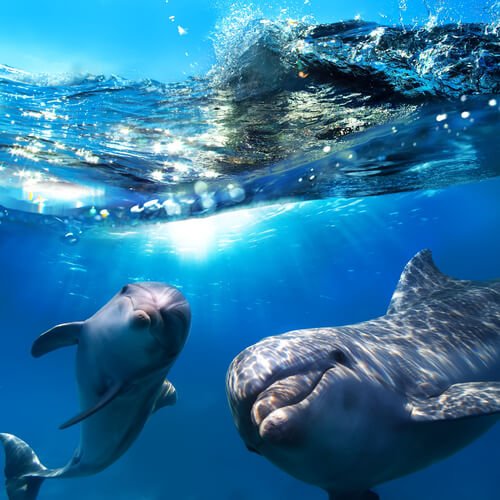Dolphin Behavior, Almost Human?

Dolphins are beautiful and intelligent animals and have always been admired by humans. Several studies and research have been done on dolphin behavior, and some amazing things have been discovered. Do you want to know what they are?
Strange Dolphin Behavior
Studies that have been done on dolphins, whales, and porpoises have shown that they have human-like behavior. This appears to have a relation to the size of their brains. To come to these conclusions, they collected information on 90 different species of dolphins, whales, and porpoises. Let’s see what they have found.
These are the dolphin behaviors that are similar to those of humans:
They work together for mutual benefit
Dolphins are always in groups. They’re social animals and aren’t afraid to depend on the group for mutual benefit. They work together and everyone benefits from each other. Whether it be traveling together, looking for food or taking care of each other.
Sharing knowledge to future generations
When new members arrive in the family, the older ones, regardless of whether it’s their parents or other members of the pod, teach them hunting techniques. Dolphins also teach them how to use several tools that can be found around the ocean in order to help them hunt.
They hunt in groups
They say that there’s strength in numbers, and this is a lesson that the dolphins have learned. Whenever they go hunting, they do it in groups in order to have a guaranteed success. Afterward, they have no problem sharing what they have hunted with the entire group. If there isn’t enough food to satisfy everyone’s hunger, they’ll continue hunting.

They talk among themselves
Everyone knows that dolphins emit peculiar sounds that help them communicate. They use these sounds to talk to each other. Also, depending on the region they live in, these sounds may be different.
Exclusive Whistles
In addition to the general dolphin language, each one of these animals has a characteristic whistle that allows them to differentiate themselves from each other. You could say it’s like their way of identifying each other.
Maternal Instinct
If dolphins find little ones that aren’t their own, they tend to take care of them, just like humans do. This is a very interesting trait that isn’t seen in many other species.
Cooperate with other species
They like to interact with other species and can even work together with in order to get food. Also, they like to participate in other activities; in short, they like to make friends.
They like to play
No matter how old they are, they love to play with the little ones or with each other. This shows that dolphins need to do more than just swim. They require an active and enjoyable lifestyle that makes them feel happy.

All of these behaviors are very similar to our own and — as mentioned earlier — have a lot to do with the size of their brains, which are exceptionally large.
So, it has been shown that whales and dolphins are extremely intelligent creatures and they’re the species whose intelligence and behavior are closest to those of humans and primates. One of the coauthors of the study that came to this conclusion said:
“Cetaceans have many complex social behaviors that are similar to humans and other primates. However, their brain structure is different than ours, which leads some researchers to argue that whales and dolphins couldn’t achieve greater cognitive and social skills. I think our research clearly shows that it’s not like that, but it brings up a new question: how can very diverse patterns of brain structure, in very different species, give rise to very similar cognitive and social behaviors?” -Kieran Fox
It’s obvious that the shape of their body hinders their ability to achieve many of the advances that we have made. However, we don’t know how far their intelligence could go. What we do know is that they’re a very intelligent species.
Dolphins are beautiful and intelligent animals and have always been admired by humans. Several studies and research have been done on dolphin behavior, and some amazing things have been discovered. Do you want to know what they are?
Strange Dolphin Behavior
Studies that have been done on dolphins, whales, and porpoises have shown that they have human-like behavior. This appears to have a relation to the size of their brains. To come to these conclusions, they collected information on 90 different species of dolphins, whales, and porpoises. Let’s see what they have found.
These are the dolphin behaviors that are similar to those of humans:
They work together for mutual benefit
Dolphins are always in groups. They’re social animals and aren’t afraid to depend on the group for mutual benefit. They work together and everyone benefits from each other. Whether it be traveling together, looking for food or taking care of each other.
Sharing knowledge to future generations
When new members arrive in the family, the older ones, regardless of whether it’s their parents or other members of the pod, teach them hunting techniques. Dolphins also teach them how to use several tools that can be found around the ocean in order to help them hunt.
They hunt in groups
They say that there’s strength in numbers, and this is a lesson that the dolphins have learned. Whenever they go hunting, they do it in groups in order to have a guaranteed success. Afterward, they have no problem sharing what they have hunted with the entire group. If there isn’t enough food to satisfy everyone’s hunger, they’ll continue hunting.

They talk among themselves
Everyone knows that dolphins emit peculiar sounds that help them communicate. They use these sounds to talk to each other. Also, depending on the region they live in, these sounds may be different.
Exclusive Whistles
In addition to the general dolphin language, each one of these animals has a characteristic whistle that allows them to differentiate themselves from each other. You could say it’s like their way of identifying each other.
Maternal Instinct
If dolphins find little ones that aren’t their own, they tend to take care of them, just like humans do. This is a very interesting trait that isn’t seen in many other species.
Cooperate with other species
They like to interact with other species and can even work together with in order to get food. Also, they like to participate in other activities; in short, they like to make friends.
They like to play
No matter how old they are, they love to play with the little ones or with each other. This shows that dolphins need to do more than just swim. They require an active and enjoyable lifestyle that makes them feel happy.

All of these behaviors are very similar to our own and — as mentioned earlier — have a lot to do with the size of their brains, which are exceptionally large.
So, it has been shown that whales and dolphins are extremely intelligent creatures and they’re the species whose intelligence and behavior are closest to those of humans and primates. One of the coauthors of the study that came to this conclusion said:
“Cetaceans have many complex social behaviors that are similar to humans and other primates. However, their brain structure is different than ours, which leads some researchers to argue that whales and dolphins couldn’t achieve greater cognitive and social skills. I think our research clearly shows that it’s not like that, but it brings up a new question: how can very diverse patterns of brain structure, in very different species, give rise to very similar cognitive and social behaviors?” -Kieran Fox
It’s obvious that the shape of their body hinders their ability to achieve many of the advances that we have made. However, we don’t know how far their intelligence could go. What we do know is that they’re a very intelligent species.
This text is provided for informational purposes only and does not replace consultation with a professional. If in doubt, consult your specialist.







